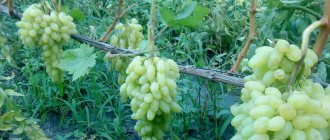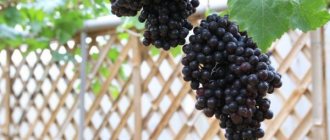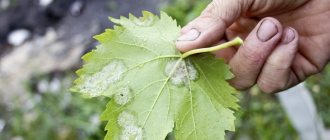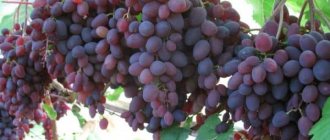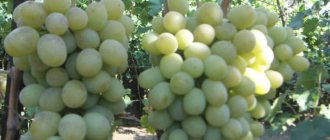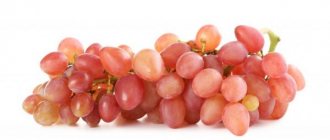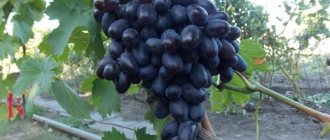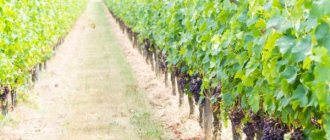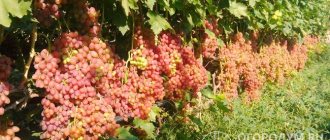Description and characteristics of black Kishmish grapes
The grapes of this variety are mid-season, table. The bush is vigorous, the length of the vine is up to 2-2.5 m. Its leaves are medium-sized, strongly dissected, three-lobed, dark green. The flowers are bisexual, emerald green. The berries ripen 3 months after the start of flowering.
The clusters of the Kishmish variety are cylindrical-shaped, dense, their weight is 300-700 g. The berries are not very large, oval, elongated at the top and slightly flattened at the bottom. One berry weighs 2.7-3 g, dark blue with a bluish waxy coating. The pulp is juicy. The taste is delicate, fruity, high sugar content, 22-27%.
Dark Kishmish is used fresh, dried, compotes are made from the berries, and raisins are in demand in baking.
Agrobiological characteristics
The growth vigor of grape bushes is high. The leaf is medium-sized, usually round, consists of three or five lobes raised upward, with strong dissection between them. The profile of the leaf blade is funnel-shaped or strongly wavy. The front side of the leaf is dark green, net-wrinkled, the back is bare and pubescent. The upper side notches are medium or deep, often open lyre-shaped with a rounded bottom, less often closed with an ovoid opening. The lower notches are small or medium, in most cases they have the shape of an incoming corner. The petiole notch is closed, practically without a lumen, sometimes slit-like. Petioles are of moderate length, light green, without bright anthocyanin shades. The teeth along the edges of the leaf are triangular and saw-toothed, have convex edges and sharp apices. The flowers are bisexual, and therefore do not experience problems with fertilization, forming well-made clusters without signs of peas. Shedding of buds and ovaries also does not occur. The annual vine ripens on time and to a sufficient length, turning brown with darker nodes than internodes.
The grape bunches are not gigantic in size, reaching an average weight of about 300-400 grams, and have a conical or cylindrical-conical shape, sometimes with wings. The structure of the Kishmish black brush can be from moderately loose to quite dense. The appearance is very neat and attractive due to the excellent evenness of the berries. Combs of moderate length, green, herbaceous. The grapes are medium-sized, oval with flattened bases and rounded tops. They reach 15−17 mm in length and 12−13 mm in width. They are painted almost black and covered with a thick layer of protective spring of a bluish tint. The average weight of 100 berries is 250−300 grams. Due to the not too tight fit to each other, no damage or deformation of the grapes is observed. The pulp is dense, orientally crisp with a noble, refined taste and neutral aroma. The juice squeezed from the fruit is very sweet - the amount of sugars ranges from 22-27 g/100 ml, while the acidity is quite low - 4-5 g/l. The skin is thin, barely noticeable when eaten. the seeds do not develop, due to which the variety belongs to the highest class of seedlessness and has excellent taste. The tasting characteristics of both fresh and dried products always deserve the highest marks.
The resulting harvest can be used in a variety of ways. As a dessert grape, Black Kishmish enjoys great success for direct consumption. Manufacturers sell it both on the local market and export it in large volumes abroad. This is facilitated by the high transportability of the bunches, thanks to which they do not lose their presentation at all after moving over long distances. Its shelf life is average, and to achieve significant shelf life it will be necessary to reduce the room temperature to +1...+3°C. As a raw material for processing, our hero performs excellently when dried. High-sugar berries provide an exceptional taste to the finished dried fruits. The yield of sultanas reaches 25−30% of the weight of the crop. Drying is done mainly in the sun without pre-treatment, resulting in a variety called Shagani. And finally, certain volumes of these grapes are used in winemaking. It produces a wide variety of types of drinks: dry wines and wines with residual sugar, port wines, Cahors. However, in varietal form they are not always of high quality, and therefore are used only in blends with other wine materials.
The ripening period of our hero is estimated as relatively early due to the fact that the duration of the growing season from bud break in the spring to the onset of removable ripeness is 125-130 days. But at the same time, it is necessary to take into account that in its usual regions it grows in conditions of sweltering heat, and therefore the sum of active temperatures at the time of ripening can reach 3000−3500°C. In our country, such indicators are typical only for the very south, and therefore it makes sense to conduct experiments on cultivating the Central Asian variety only in the most warm regions. Moreover, here you can only count on table use of the grape harvest, while to obtain high-quality dried fruits you will need an even higher level of SAT. In addition, we should not forget about the very low frost resistance of Black Kishmish. Its vine suffers significant damage already at -16°C, and at -18°C, uncovered bushes die. This feature forces amateur winegrowers to take the issue of plant insulation very seriously during the cold season.
The productivity of the variety is another remarkable aspect of it. Under conditions of a suitable climate, good care and irrigation, which is mandatory for arid regions, vineyard productivity can reach 30 tons per hectare. Such a high figure is possible, among other things, due to the fact that in the Central Asian republics the bushes do not need to be covered for the winter and are given the opportunity to accumulate large volumes of perennial wood, which has a very positive effect on both the large fruit size and the ability of plants to bear a truly colossal load. Domestic winegrowers are limited in this possibility, which is why they receive very modest yields using relatively compact covering formations. Moreover, here the bushes can show a tendency to overload, reducing the activity of shoot growth, lengthening the growing season and deteriorating the quality of the grapes. This requires additional attention and a sensitive response from the owner to such problems.
Ripe berries practically do not crack even in rainy weather, and therefore can continue to hang on the bushes for quite a long time. In this case, measures should be taken against gray rot, because without this, the grapes may begin to spoil. Wasps also do not bypass our hero, which is why the crop must be protected from them.
Advantages and disadvantages
Kishmish has a number of advantages:
- the berries do not contain seeds;
- brings a large harvest - 250 centners per hectare;
- brushes can be transported over long distances;
- Easy to care for, like other varieties;
- the berries do not crack in rainy weather;
- used for making wines, dried fruits, soft drinks.
The disadvantages of the variety are intolerance to low temperatures, susceptibility to diseases - oidimum, anthracnose and attacks of pests - wasps, leaf rollers. After ripening, the berries must be removed immediately, otherwise they will lose their taste.
Advantages of the variety
In addition to the fact that the berries have very small and almost invisible seeds, sultanas have the following advantages:
- Relative resistance to diseases characteristic of these plants;
- Frost resistance. Tolerates temperatures down to 20–25 degrees below zero;
- Transportability of berries;
- High yield. With the right agricultural technology, you can grow up to 250 centners per hectare;
- Simple care of bushes: formation, watering, fertilizing, pest and disease control.
Features of cultivation
They take into account the timing and select the right place for the grape variety.
Planting period
Kishmish grapes are planted in autumn or spring; in cold regions it is recommended to do this in spring. Over the summer, the root system will strengthen. In the south, this variety can be planted in the fall. They purchase material for planting in specialized stores and nurseries, where there is a guarantee.
See also
Technology for growing grapes in a polycarbonate greenhouse, pruning and careRead
Site preparation
Choose a place for a perennial plant that is free, unshaded, and protected from the wind. The best option is south, southwest with a slight slope.
The Kishmish variety is suitable for sandy loam, loamy, chernozem, and chestnut soils. The area is dug up in advance and humus is added - 3-4 kg per 1 sq. m. m and superphosphate - 100 g per 1 sq. m. Add phosphate rock to acidic soil, and coarse sand to clayey soil.
Planting process
Grape bushes are planted at a distance of 2.5 m, between rows - 3 m. The roots of the seedlings are trimmed and placed in water for 1-2 days.
First, holes measuring 80 x 80 cm are dug. Drainage made of gravel is laid at the bottom. The soil is mixed with rotted manure, superphosphate, and potassium salt. The seedling is installed, sprinkled with soil, leaving 2 eyes above the surface. Water using two buckets per bush. They install special supports - posts with tensioned wire. The soil is mulched with straw and rotted sawdust.
Specifics of plant care
In May, the regrown grape vine is tied up, in June it is pinched and the shoots are removed. In July the tops are pinched off. The tree trunk circle is cleared of weeds and loosened. The bush is formed in different ways - in the form of a fan sleeve or formation on a trellis. Weak, diseased, frozen shoots of the grape variety are removed in the spring.
Watering and fertilizing
Kishmish does not require heavy watering. Every 4 days, the variety bush needs 2-3 buckets of water. It is better to use drip irrigation. Water in the spring before and after shoots bloom, during active growth. Before harvesting, do not water for 2 weeks .
Before the growing season, nitrogen fertilizers are applied to the grape bush, then phosphorus-potassium fertilizers. In the fall, nitrogen fertilizing is not required for grapes; organic matter is added, then complex mineral mixtures.
Preparing for winter
In the fall, the vines are pruned. The formation of a bush variety involves 8-10 shoots per linear meter. Leave at least a meter between the sleeves.
After removing the berries and pruning before the onset of cold weather, the bushes are treated with solutions of iron and copper. Fallen leaves are removed.
To protect against cold weather, the vines are tied and placed in dug trenches to a depth of 20 cm.
Sprinkle with soil, making a 30 cm mound, or use agrofibre and create a canopy of branches. In addition, you can use straw and corn stalks.
Application of sultana berries
Kishmish berries are very tasty fresh. After special drying, you can obtain raisins, which are subsequently used for baking and preparing other culinary dishes. Kishmish is used to make candies, jam, and added to drinks.
Several methods are used for drying in the garden. One of the oldest methods of “aftobi” was used specifically for Black Kishmish in its natural habitat, where the berries had time to dry without treatment before the rainy season. The bunches are laid out on a wooden base in a thin layer and dried for about 18–20 days. At a humidity of 18%, the yield of quality products is up to 25%.
In its pure form, sultana wine is almost never made, but the berries can be part of a blend for wines such as port, Cahors and other dessert types.
Did you know? Raisins from black Kishmish are called “shigani”, and from white
—
"bedona". In ancient cookbooks you can find dark raisins under the name “cinnamon”.
Description of diseases and pests
Grapes are often affected by diseases. For prevention, you need to spray the bushes with Bordeaux mixture or take Ridomil Gold. Frequency: three times per season. This is done in the fall, after the leaves fall, in early spring before the buds open, during the growing season when the shoots reach 12-15 cm.
See also
Description and characteristics of the Krasotka grape variety, ripening time and careRead
Oidium
Powdery mildew first appears as small white spots on the buds. Then a white coating forms, turning into brown spots with an irregular gray coating and a moldy smell. The inflorescences stop growing, dry out, and fall off. If the berries are affected, they burst, harden and rot. The grapevine is treated before and after flowering. Repeat after 20 days and in early August. Preparations for oidium - colloidal sulfur, Strobi, Vectra, Tilt.
Mildew
Fungal spores germinate in wet weather. There are yellow oily spots on the leaves and veins. There is gray fluff on the underside, then it moves to buds and flowers. The berries turn brown, burst, and ooze juice. The bushes need to be ventilated, the affected parts should be burned, treated with fungicides - copper oxychloride, Polyram, Thanos, when fungus appears and for prevention.
Pests
The grape budworm loves grapes. She feeds on ovaries and berries. When it appears, treatment with insecticides is necessary.
To protect juicy berries from the invasion of wasps, they are driven away with smoke or special bags are put on each bunch. They set up glass traps with poisonous bait. In some cases, chemical treatment is used.
Properties for raisins and wine
Black raisin grapes, and indeed, like any other grape varieties, have many beneficial properties. The berries contain large quantities of vitamins A, C, B and others. Organic acids (oleic, stearic). Black sultana fruits are rich in glucose, fructose, and sucrose. By taking grapes in sufficient quantities, you can forget about colds for a long time. And just two or three spoons of steamed raisins will help get rid of an annoying cough or sore throat.
Black sultanas are rich in glucose and fructose, which make it one of the sweetest fruits grown by humans.
There are manuscripts written by ancient healers of the East and Central Asia, which mention the beneficial properties of raisins made from black sultanas.
Calorie content
When creating diets for weight loss, they include a variety of fruits and vegetables, and not just certain foods rich in proteins, for example. And grapes are often recommended there as a healthy product with a relatively low calorie content. Mostly table varieties whose berries are black or red are included in diets. It is believed that the energy value of grapes depends on its color. Although this is not entirely true. It’s just that dark-colored grapes have slightly higher acidity and lower sugar content compared to green, amber berries. But this does not apply to black sultanas. It has both high sugar content and energy value. The calorie content of black sultanas is 69 kcal per 100 grams of product. It is no longer used for fresh consumption, but in baking or canning. Read about the characteristics and description of the Blagovest tomato variety here.
Benefits and harms
It is advisable to consume grapes for:
- Heart diseases;
- Hypertension;
- Gastrointestinal pathologies;
- Low acidity of gastric juice;
- Exhaustion of the nervous system;
- Great physical activity;
- How to prevent rickets in children.
It is difficult to overestimate the benefits for the human body from regular consumption of grapes.
But there are also contraindications:
- Obesity;
- Diabetes;
- Stomatitis and other diseases of the oral cavity;
- Increased acidity of gastric juice and more.
Acidity
Professional winegrowers monitor the acidity of the juice during the ripening period of the berries in order to subsequently obtain high-quality wine products from them. But lovers pay more attention to this indicator, because it affects the taste. Sour, unripe grapes are not enjoyable to eat. Acidity can be low (3 g/l) or high (over 9 ppm). Black raisin has average acidity (from 4 to 5 g/l). With a sugar content of 22–27 percent. This article will tell you about wine made from grapes at home.
Grapes and products made from them are a good choleretic agent and are used to treat various liver diseases.
Varieties of Black Kishmish
Kishmish has several varieties with excellent berry taste and immunity.
Black finger
The second name is Black finger, selected in Israel. The variety is distinguished by elongated large berries up to 3 cm long, weighing up to 14 g. Its clusters are 1-1.5 kg. The skin is dense. It is immune to diseases and can withstand frosts down to –20 C. Tasty, sugar content 20%. After the beginning of the growing season, it ripens in 150 days.
Black emerald
It's called Black Emerald. Early variety, American. From the beginning of the growing season, the berries ripen 105 days later, at the end of July. Clusters weighing 400-600 g, berries 3-6 g with dense pulp. The brushes weigh 500 g. Its productivity is very high, but it is not resistant to disease. Tolerates temperatures of –23 C.
Growing Kishmish - what kind of grape is it?
Kishmish grapes are known for their special taste and lack of seeds. Breeders have created many new varieties suitable for different climatic conditions. How to grow it is described in detail in this article.
Grapes Kishmish
It is known for its sweet taste and the absence of seeds in the berries. Kishmish grapes are grown throughout the Russian Federation.
Description and characteristics
The name of this species comes from a Persian word that translates to “dried grapes.” Kishmish has such small bones that you can hardly feel them when eating. These grapes are not the result of deliberate work by breeders, but are a mutation that occurred naturally.
For your information! Since the quality of these berries attracted the attention of gardeners, various varieties were continued to be developed based on this species.
Kishmish fruits are collected in dense, slightly loose clusters. The berries are medium in size. Their color differs among different varieties.
Kishmish berries are dense and keep well. Most varieties have no seeds at all, but some do have them, but they are very small and cannot be felt when eating. The pulp is sweet. The sugar content in grapes is 18-25%.
Advantages and disadvantages
This variety, in accordance with the description, has the following advantages:
- is well stored during the winter (at least 180 days);
- easy to transport;
- has beneficial properties for the body;
- good yield;
- pleasant sweet taste.
Disadvantages include weak resistance to diseases (gray rot, mildew) and low frost resistance (up to −18 ° C).
Note! On the Internet you can find “Quiche Mish grapes”, but this is a mistake. In the State Register, this variety appears only as Kishmish.
Scope of application
These grapes are used not only for food, but also for making high-end raisins. The fact that it has no seeds allows us to make a high-quality product. Also, these grapes are actively used for making wines and juices. It is characterized by sweetness and high calorie content.
Note! This plant can be used for decorative purposes.
Growing areas
Initially, this very early variety grew in the southern regions of the country. After breeders worked on Kishmish, varieties were developed that grow well on a significant part of the territory of Russia.
